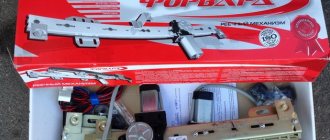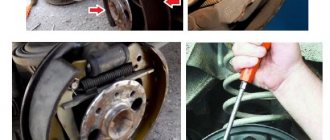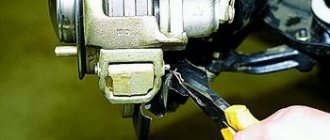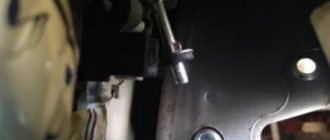Modern Lada
Most Lada Priora owners know that the domestic car has front disc brakes and rear drum brakes. It is no secret that the drum braking system was developed a long time ago, back in the middle of the 20th century, and no longer meets current standards.
In the modern automotive industry abroad, you can hardly find drum brakes anywhere; many companies have switched to rear disc systems. The only exception is budget cars, which cannot afford to have a better braking system.
Rear brake discs can be installed on almost any front-wheel drive vehicle of the VAZ family, including modifications with ABS. If you care about your convenience and comfort, then it’s time to think about installing brake discs for the Priora. In addition to comfort, the ZDT system significantly increases the safety of the car, and this is very important on unreliable Russian roads. Let's consider whether it is worth installing disc brakes on the Priora, as well as their advantages and disadvantages.
Advantages and disadvantages of rear disc brakes
Rear brake discs are installed on foreign cars not only because of their high efficiency, but also to ensure simultaneous and uniform operation of the braking system. If any mechanism operates more sharply or slowly, this will entail a loss of control over control.
Disc brake unit
Rear disc brakes have the following advantages.
- The braking distance is reduced several times.
- Brake response time is noticeably reduced.
- Frequent maintenance is not required, brake pads can be replaced without much effort.
- Increased security.
- Uniform operation of the braking system.
- Unsprung masses are noticeably reduced.
- Fast heat dissipation, which is essential at high speeds or when cornering sharply.
- The need to constantly tighten the handbrake is eliminated.
- Aesthetic appearance.
- They do not freeze in the cold season after washing (a similar problem is observed in drum brakes).
It is worth remembering that the Volzhsky Automobile Plant does not install rear disc brakes on the Lada Priora, based on its standards. By replacing drum brakes with disc brakes, you will be making changes to the stock configuration of the car, which will affect its technical characteristics.
Rear disc brakes have their drawbacks. For each brand of car, good braking systems are developed over a considerable period of time, based on the technical characteristics of the model and certain standards. In other words, the stock brakes are always well balanced and tuned.
A typical mistake of inept installation
Buying a new brake system and simply installing it will not achieve the desired result. Rear disc brakes need to be adjusted and their functionality checked in the field. Otherwise, you will encounter problems such as uneven operation of the brake system, which will lead to skidding, whistling, squeaking and even overheating.
Disc Brake Maintenance
| № | Service |
| 1 | To service the rear disc brakes, the machine is placed on a jack and the rear wheels are removed. The caliper fingers are unscrewed, then the bracket is attached to the steering knuckle (to simply replace the pads, the bracket attachment does not need to be removed). Next, you need to check the working thickness of the brake disc. If it is no less than 17 mm, everything is fine. |
| 2 | The retaining plates of the brake pads are cleaned, and a special lubricant is applied to the pads themselves. |
| 3 | Lubricant is introduced into the brake caliper through special holes in it. |
| 4 | New pads are installed. |
| 5 | Reassemble the entire system in reverse order. |
So, in general terms, we can describe how rear disc brakes are serviced. A set of rear brakes for VAZ, including Priora, will cost about 9,000 rubles. plus service. Disc brakes provide stable and safe driving at speeds over 100 km/h, unlike drum brakes, which can fail in a critical situation. Rear disc brakes are a significant investment in safety.
Priora meets high safety standards, and rear disc brakes significantly increase it even in extreme situations. Ventilated brake discs are particularly effective. This is all the same both when installing brakes on a Priora with ABS and one not equipped with it.
You can get acquainted with the repair services of brake discs at the link - www.remontdiskov.ru.
What are the risks of installing a non-standard brake mechanism?
Installing brake discs on a Priora does not always have a good effect on the car. Of course, the costs will pay off and you will get the desired effect, but at the same time, some problems may arise.
- You may fail your MOT inspection as it is illegal to tamper with the car's standard equipment, although rear disc brakes have a number of advantages over drum brakes.
- Since the rear disc brakes are very conspicuous, a meticulous law enforcement officer on the road may well find fault with the presence of non-standard mechanisms installed on the car. But in most cases this is rarely paid attention to.
- There may be problems fitting a standard cable handbrake. Installing a hydraulic brake will help here, allowing you to brake at high speed, but weakening over time if used as a parking brake. Some car enthusiasts completely refuse to have a handbrake and even manage to pass MOT without any problems.
- If you get into an accident, the scales will tip against you due to the presence of non-standard spare parts in the car, even if you are not the culprit.
Having installed rear disc brakes on the Lada Priora, you need to start adjusting the brake force distribution system, which is called the “Sorcerer”. If this is not done, the rear brakes will apply faster than the front brakes. This will lead to unwanted skidding, worn tires, squealing and overheating of the disc brakes.
Sometimes skillful owners take on the grinding of brake pads themselves, reducing their contact with the brake discs by up to 50%.
How disc brakes are superior to drum brakes
Rear disc brakes have a number of advantages:
- The efficiency and reliability of the braking function is improved.
- The time it takes for the brakes to apply is noticeably reduced.
- Safety during vehicle operation increases significantly.
- Brake pads do not require special maintenance efforts.
- The car takes on the most representative appearance.
- After washing the car in winter, the disc brake system does not freeze.
- When driving at high speeds, heat dissipates instantly.
There are nuances when using rear disc brakes; it takes a lot of time to develop a high-quality braking system for different car models, taking into account existing requirements. Specifically speaking, excellent tuning and balancing was done on the stock brakes.
On a note! After installing the disc brake system for the rear wheels, it is important to carry out the adjustment procedure and be sure to check their functionality. Otherwise, troubles associated with uneven braking may occur and endanger the lives of the driver and passengers.
Selecting rear brake discs for Priora
One of the main advantages of installing brake discs yourself is significant savings in money, about 10,000 rubles.
Important: when carrying out installation, it is better to purchase devices with a certificate and install them in specialized service stations, which also provide certificates stating that the brake system is adjusted and meets all standards. However, this will not provide any guarantee that you will not be picked on during maintenance.
If you still decide to install the brake system yourself, then you need to decide which brake discs are best to install. Of course, you can go to the auto parts market or look for suitable ones on the Internet. It is also possible to adapt front disc brakes from the same Priora or any other car of the VAZ family. If you're a speed enthusiast, you might be interested in ventilated brake discs, which provide much better cooling and help prevent overheating.
Spare part from a reliable brand
The most common and high-quality solution in Russia are Italian Brembo brake discs, which are widely used throughout Europe and are certified by the German Federal Bureau of the Automotive Industry. Brembo has a wide range of discs, among which you can find those that suit you, including price. In addition, Brembo has official technical support in Russia.
Brake discs from this company can be installed in conjunction with any other pair, since they do not require in-depth adjustment. If you have extra money, you can also buy Brembo MAX front brake discs, which are produced specifically for cars of the VAZ family, including Priora.
Thanks to the presence of a special wear indicator, brake discs will be replaced in a timely manner. There is a notch on the disc that completely disappears when the disc wears out, allowing you to determine its reliability at any time.
What front brake discs can be installed on the Lada Priora?
It should be noted that the front brake discs constantly heat up and are subject to greater loads than the rear ones. That is why their replacement is necessary more often than the rear ones. But it is important to familiarize yourself with all the dimensions in advance. Before you make a purchase, you need to decide on your budget. Original disks are usually slightly more expensive than analogues.
ATTENTION! A completely simple way to reduce fuel consumption has been found! Don't believe me? An auto mechanic with 15 years of experience also didn’t believe it until he tried it. And now he saves 35,000 rubles a year on gasoline! Read more"
At the same time, it is important to remember that the latter are sometimes in no way inferior in quality to the originals. Some famous brands have the status of official suppliers. Therefore, the quality of the products they supply is satisfactory. The price fluctuates depending on various factors. It is necessary to take into account all the nuances. If the car has ABS, discs are required, which require connecting the corresponding sensors.
The price also varies depending on the brand. Such as TRW and Ferodo will cost slightly more than noname products. The cost of ventilated and conventional ones varies. The latter are suitable for drivers practicing an aggressive driving style. They cool down much faster. Moreover, the pedal will be more responsive. But the cost of such disks is much higher.
Original
Many drivers choose original parts. Moreover, there is a certain logic in this. Since such components are 100% likely to fit. It is only important to study all offers in advance. Counterfeits of original components and parts are often found on sale. There is a hologram on AvtoVAZ boxes; the box itself is made of high-quality cardboard.
| Name | vendor code | Cost, rubles |
| LADA | 21120-3501070-02 | From 1 thousand rubles |
Substitutes
Purchasing analogues does not cause problems. It is only necessary not to confuse the article. The minimum cost of such components will be 800 rubles. Having installed such items, it is important for the owner to constantly monitor their condition. This will avoid many difficulties. It is better to replace the disks in advance.
| Name | vendor code | Cost, rubles |
| BREMBO Brake disc VAZ 2110-2112 R14 front ventilated | 09.8903.14 | From 1.2 thousand rubles |
| BOSCH Brake disc VAZ 2110-2112 R14 front ventilated | 0 986 479 346 | From 1.4 thousand rubles |
| MILES Brake disc VAZ 2110-2112 R14 front ventilated | K000075 | From 1 thousand rubles |
Installation of the HTD on Priora
- Stage 1
The rear drum brakes need to be removed. If you have any difficulties, you can refer to the Lada Priora service manual. Carefully remove the hub from the lever while still assembled. The brakes on a Priora with ABS are removed by first removing a special sensor with a clip from the supporting panel. Disconnect the connector and prepare the necessary spare parts for installation along with the ABS sensor fasteners.
Clean the pressure controller, its spare parts, the disc release ring journal and the hub axle. The presence of dirt on the coating can affect incorrect balancing. Unscrew the screw that holds the cable brackets and remove it.
Installing new brakes
- Stage 2
Proceed with the installation of a special adapter plate, a cover with protection against dirt and the hub axle. It is necessary to connect the adapter plate to the housing right in the middle of the beam and the hub axle. There is no need to remove the hub from the axle. The bolts are attached to the flanges using screws with groovers. The bolts must be tightened using a torque wrench, which is designed to regulate the tightening torque. It should be 5.6 kgf/cm. If the tightening is less than necessary, this will eventually lead to deformation or even complete destruction of the disks, making it difficult to unscrew the bolts.
- Stage 3 (brakes on Priora with ABS)
Attach the 9 mm plastic sensor spacer. Install the ABS bracket and the sensor required for its operation using the standard fasteners and screws. Install the ABS sensor into the trigger connector and connect it. Check whether the sensor is touching the rotor coating; to do this, simply spin the disk. The gap should be about 1 mm.
- Stage 4
The guide caliper bracket is installed on the adapter plate using screws with groovers and washers. The tightening moment should be 5.6 kgf/cm.
- Stage 5
Attach the brake disc to the hub using two guide rods and begin installing the caliper. It must be installed with the fitting facing up. Apply glue to the rod bolts, insert the first one into the armhole and tighten thoroughly. Adjust the cylinder and attach the brake pads. Tighten the second bolt taking into account a tightening torque of 2.5 kgf/cm.
- Stage 6
Apply lubricant to the handbrake cable spring and insert it into the armhole of the bracket. Attach the bracket and cable to the beam using a screw clamp, first disconnecting it and threading it into the bracket itself.
- Stage 7
It is necessary to disconnect the cable from the handbrake and remove the mudguard. Remove the cable from the caliper and dismantle it by unscrewing the fastening hardware. The brake cylinder must be carefully brought in by turning it with a wrench and thus checking whether the pads pass freely between the caliper and the brake disc. It is worth taking a closer look to see if the protrusion on the block fits into the opening on the caliper piston. Pass the cable through the armhole of the holder and secure the protective rubber cover.
The cable loop is put on the handbrake trigger. The brake hose is attached parallel to the surface of the beam arm flange, and the hose tip is screwed into the caliper using a hydraulic rod.
Installed unit
- Stage 8
Finally, you need to connect the brake line. Bend the brake pipe so that the tip can be positioned at the hole in the handbrake cable bracket. Insert the tip of the hose into the opening of the bracket, fasten the brake pipe to it and securely fix the structure.
Check again to make sure everything is securely fastened and screwed down. All elements must be connected correctly.
Rear disc brakes for classics with two calipers VAZ 2101, 2102, 2103, 2104, 2105, 2106, 2107
Kit for installing rear disc brakes on classics with two calipers on one side. The kit includes:
Brake pads – 2 sets
Brake caliper – 2 sets
Brake discs – 1 set
Faceplates for transition – 1 set
In warehouse in Samara
Our online store tuningprosto.ru offers an assortment of rear disc brakes for VAZ cars using Lucas components. Rear disc brakes have become increasingly popular recently. When increasing the power of the car, special attention should be paid to the issue of tuning the brake system. Unlike drum brakes, disc brakes have a number of significant advantages. They increase braking efficiency while reducing stopping distances by 20%. Disc brakes heat up less, they are easier and cheaper to maintain, they do not jam in winter when they get wet, etc. The main emphasis when installing a brake brake is the difficulty in correctly distributing the braking force on all axles, therefore the diameter of the rear brake discs should be less than the diameter of the front ones. Rear disc brakes also add to the aesthetics of your car.
Maintenance Recommendations
After the installation of the HCD is completed, grinding and heating of the working coating may occur, which is caused by the grinding in of new spare parts. Do not try to brake hard until you have driven 350-550 km so that the new parts can get the necessary break-in.
In combination with rear brake discs, it is advisable to install Brembo MAX front discs on the Priora. This will allow you to achieve the highest quality of uniform braking. In addition, front disc brakes will give an organic and aesthetic look to your car.
We recommend reading:
- If the Priora engine stalls when cold
- The procedure for replacing the fuel filter on a Priora
- Replacement of rear struts: done on Priora
- Common error codes for Lada Priora
- Selection of oil for the Priora gearbox
- What is Priora tuning?
Checking the rear brake pads of Lada Priora
It is better to check the rear pads on an overpass or inspection pit. On the brake mechanism shield you can see a special inspection hole closed with a rubber plug.
We take out the rubber plug and assess the condition of the pads. The thickness of the working surface of the pad must be at least 1.5 mm . If less, such pads require replacement.
If you find chips or grooves on the pads, it is also advisable to replace such pads, as braking efficiency decreases.
Stages of work on installing brake pads on the rear of the Priora
Considering the structure of the HAZ assembly, the hub is connected directly to the beam of the rear of the car on both sides. It has a braking disc and ensures the necessary rotation of the wheel system. The caliper, consisting of a hydraulic brake system, is also connected to the rear beam using a faceplate.
The caliper includes an integrated parking brake system or no parking brake. For sport class vehicle models, a manual brake system is not provided.
To eliminate the disadvantages of braking with the rear axle of a vehicle, remember that the best solution would be to install braking discs that have a smaller diameter compared to the front ones.
To carry out a qualitative change in the mechanism of the rear wheel braking system of a Priora model car, it is necessary to take into account three features.
- Braking discs produced for models with front-wheel drive have sizes from 13 to 14 inches, are divided into types: ventilated disc size from 14 inches (2112), ventilated disc size from 13 inches (2110), non-ventilated disc size from 13 inches (2108 ).
- The caliper is also classified into the same types, which directly depend on the discs used for installation. It comes complete with brake pads and a hose.
- If it is necessary to carry out work to attach the beam located at the rear of the machine, a faceplate is needed.
We begin work on installing the disc braking system:
- The rear axle drum brake system is dismantled. If the work becomes difficult, you can refer to the instructions for servicing the Lada Priora vehicle. Then you need to remove the hub from the lever as carefully as possible. After disconnecting the anti-lock braking system sensor (which prevents the wheels from locking when braking) from the carrier panel, you can begin to remove the brakes. Be sure to make sure that the connector is disconnected; do not forget about the fastening of the anti-lock braking system sensor.
Be sure to remove dirt from the pressure controller and all its parts, the neck of the trigger ring disk, and be sure to clean the hub axle. Poor cleaning will negatively affect further balancing. Be sure to remove the cable by first removing the screws.
- First, you need to install the adapter plate, a protective casing to prevent contamination, and also the hub axle, having previously fastened the casing to the plate in the middle, on the hub axle to the beam. Using torque screws, the bolts are secured; you need to tighten them very carefully, no more than 5.6 kgf/cm using a torque wrench that regulates the tensioning process itself. If the tension is not sufficient, the integrity of the discs will subsequently be destroyed or deformed.
- We attach the washer of the remote plastic sensor, the parameters of which are at least 9 mm. Subsequently, an ABS bracket is mounted in the launch hole and connected. It is very important to ensure that the sensors do not come into contact with the rotor; to check, just spin the brake disc, if a gap of at least 1 mm is maintained, everything is in order.
- Installing the guide caliper bracket onto the adapter plate, using locking screws and the necessary washers, and the tension must be at least 5.6 kgf/cm.
- Braking discs are mounted on the hub using two pieces of rods as guides, and a caliper is also mounted. Be sure to make sure that it is installed with the fitting facing up. First you need to coat the rod bolts with glue, insert the first one into the armhole and tighten it well. Be sure to adjust the cylinders before attaching the brake pads. Moreover, the second bolt must be tightened to no more than 2.5 kgf/cm.
- Be sure to lubricate the spring from the handbrake cable and attach it to the bracket. Only after this procedure do we fasten the following parts using a screw clamp: cable and bracket to the beam.
- Then the handbrake cable is disconnected and the protective cover is detached. Remove the cable from the caliper structure; the mount must be dismantled. Be sure to make sure that the pads move freely without interfering with the brake rotor and caliper, and be sure to note that the protruding part of the pad fits exactly into the opening of the caliper piston. Then you need to secure the cable using a protective rubber cover. Place a cable loop on the manual drive trigger. Be sure to firmly attach the brake hose, keeping parallel between the top of the flange from the beam arm, and part of the hose is screwed into the caliper system.
- The final process in the work will be connecting the brake line. The brake tube must be bent slightly so that its tip is located next to the opening of the hand cable bracket. The end of the hose is inserted into the hole in the bracket, connected to the brake pipe, and the whole structure is fixed quite firmly.
Important! Be sure to check the correct assembly of the entire structure and the reliability of the connections.
After installing rear disc brakes, before all the new parts are ground in, the coating heats up and possibly grinds. Until the mileage of the vehicle with new parts is 300 - 500 km, you should not suddenly brake, because... new parts have not yet been processed properly.
Progress
First you need to dismantle the old mechanism.
After you remove the wheels, you will be faced with the hubs, which need to be removed from the rear beam. If you have a Priora with ABS, you will need to additionally remove the sensor from the supporting panel. You will also need to remove the screw from the cable bracket. At the same time, you should already have on hand all the necessary materials to replace the brakes and clean parts that will not be dismantled. Clean components and sensors. Further work includes the following steps:
- Installing the adapter plate.
- Securing the sensor washer. This is necessary for vehicles equipped with an ABS system.
- Installation of the ABS bracket, as well as a special sensor designed for its operation.
- Installing the caliper bracket.
- Mounting the disc on the rear beam.
- Lubricating the handbrake spring, threading the cable into the bracket, fixing the bracket.
- Disconnecting the handbrake cable and adjusting the cylinder.
- Brake line assembly.
The work is quite complex as it needs to be done with extreme caution. Otherwise, you may be left without brakes or face the need for an emergency replacement.
| 1 | To service the rear disc brakes, the machine is placed on a jack and the rear wheels are removed. The caliper fingers are unscrewed, then the bracket is attached to the steering knuckle (to simply replace the pads, the bracket attachment does not need to be removed). Next, you need to check the working thickness of the brake disc. If it is no less than 17 mm, everything is fine. |
| 2 | The retaining plates of the brake pads are cleaned, and a special lubricant is applied to the pads themselves. |
| 3 | Lubricant is introduced into the brake caliper through special holes in it. |
| 4 | New pads are installed. |
| 5 | Reassemble the entire system in reverse order. |
What is the danger of installing a non-standard braking mechanism?
It is important to know that after installing a disc brake system, you will get the desired effect, but at the same time you will encounter some problems.
- When changing the standard equipment, be prepared for the fact that your car will not pass inspection at a service station, because... any interference in changing the configuration is illegal, despite all the advantages.
- It may be difficult to attach the handbrake system. A possible solution to this problem would be to install a hydraulic brake, which performs braking functions when driving at high speeds. But this type of brake also has disadvantages; it weakens if it is used when the car is parked. The most desperate car owners completely dismantle the handbrake, and maintenance is carried out without any problems.
- If an unpleasant situation happens and you get into a traffic accident, perhaps if a spare part is found that does not correspond to the configuration of this vehicle, the decision will not be in your favor, regardless of whether you are at fault or not.
After installation, the rear disc brakes on the Priora need to be adjusted by equally distributing the brake forces. This important process cannot be ignored, otherwise the rear brakes will work more quickly than the front ones. The consequences can be unpredictable, for example: overheating of the brake system, sudden drifts that can lead to undesirable consequences, or worn out tires.
Some craftsmen grind off brake pads by almost 50% with their own hands, reducing friction during braking.
So, let's consider the important factor of the need to set up a clear determination of the braking force of the car using the rear axle.
Looking at the car from below, you can see a regulator located to the left of the beam, which ensures stable brake fluid pressure. It is important to know that disc brake systems, unlike drum brakes, require much less fluid pressure to brake. If this moment is ignored and the adjustment is set to the previous position, the result is that the rear wheels of the car will constantly lock, and this happens earlier than the front wheels lock. This happens because the part of the car located at the rear is several times lighter, so the braking system responds faster.
The principle of operation of the adjustment mechanism is very primitive: by pressing the valve, the force of pressure on the rear circuit increases, which means that if it is slightly relaxed, it correspondingly becomes less. The main function of this mechanism is to provide the necessary braking to the rear wheels of the car.
In this particular case, our goal is to slightly reduce the effort.
Loosening the lever attached to the beam will allow you to move it from one side to the other without much effort. If the lever is moved away from the regulator, the pressure in the rear axle will decrease to avoid over-braking of the rear wheels of the car. You may also have to do some work to adjust the flexible plate located on the lever.











